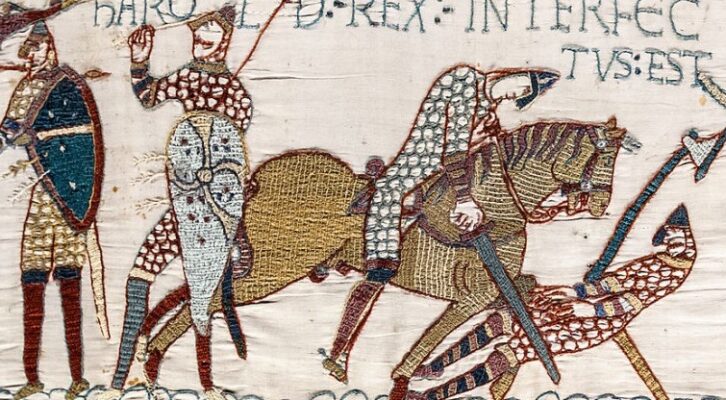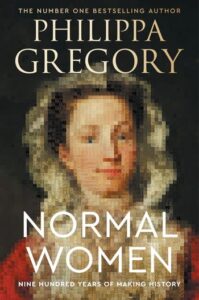
Phillipa Gregory on How the Norman Invasion Brought Patriarchy to England
“There are more penises than English women in the Bayeux Tapestry.”
The invasion of England by the Norman army in 1066—Duke William of Normandy versus King Harold of England—would be far more than a regime change for the women of England. It was the hardening of a tyranny by men who captured the kingdom and its fortune, passed it father to son excluding women, created laws enslaving women, composed religion and philosophy to denigrate women; men whose violence was directed at women, and whose need for cash and greed for profit would underpay and overwork women for centuries.
The account book compiled to establish the value of lands for royal taxation could be challenged no more than Judgment Day itself, and was named in the twelfth century as the Domesday Book. For the women of England, the Norman invasion was indeed a day of doom.
The Bayeux Tapestry, a near-contemporary 70-meter long embroidered linen panel, shows an invasion of men: 632 of them. Nearly 200 horses are depicted, 55 dogs, 500 other animals and birds—but only five women, all of them threatened or suffering violence. Anglo-Saxon Queen Edith mourns her husband Edward the Confessor; another woman (probably Ælfgifu, the wife of King Cnut—or Ælfgyva as it is on the tapestry) is being touched by a clerk or priest; a woman flees a burning building with her son; and, in the margin, a naked woman runs from a nude man with an erect penis, and another naked woman defies a naked man who holds an axe.
There are more penises than English women in the tapestry: 88 on the horses, five on the men. The expert designers, weavers and embroiderers—probably English women themselves working for a Norman lord—showed allowable male sexual violence arriving with the Normans and tolerated by them.
William of Normandy was a notoriously aggressive leader, who had already brutally conquered his homeland with a battle-hardened army. Their arrival marked the end of an England that had settled into relatively peaceful rule under Anglo-Saxon lords, inspired by a concept of “good lordship,” where women had legal rights, some owned land and their own fortune, ruled over their tenants, could marry or separate freely and could choose their heirs.
There are more penises than English women in the Bayeux Tapestry.
The Domesday Book—a snapshot of England at the moment of William’s invasion—listed 16,667 male landowners and 479 women. Among these were some extremely wealthy women: Gytha Thorkilsdottir, Countess of Wessex, mother of King Harold, owned massive estates in southern England stretching over 11 modern counties. Harold’s influential and wealthy wife Edith Swan Neck held vast lands. Two of the greatest women landowners of 1086 were not even named in the Domesday Book—they were referred to as the wife of Hugh, son of Grip, and the mother of Robert Malet.
A woman named Asa, a small landowner in Yorkshire, appeared in the Domesday records claiming her lands after separating from her husband. The jury in the case followed the old Anglo-Saxon law: Asa won and held her land in her own right. She was lucky to come under Anglo-Saxon law—the new Norman laws would rule that no wife could own land or keep it after marriage without a specific settlement. No woman would annul a marriage or divorce without permission from the church courts or Parliament for the next eight centuries.
The Domesday Book had been commissioned to show the invader the state of the land that he claimed as all his own. All the lands belonged to the king by right of conquest, and he favored his chiefs of staff with grants of land. Female ownership all but died out. In 1066, there were 25 women landholders recorded in Essex but only 9 recorded in 1086. Yorkshire listed 19 women in 1066 and 4 in 1086. Suffolk listed more than 50 women owners in 1066 but 43 of them vanished in only 20 years. The great landowners were now all Normans, all male. William did not grant any land to women except kinswomen and a few nunneries.
Anglo-Saxon women who refused to accept Norman rule found themselves landless. Gunnhildr, King Harold’s own daughter, lost all her lands and hid in a nunnery to escape a forced marriage to a Norman lord. Lower-class Anglo-Saxon women were robbed, assaulted and raped by the invading soldiers. Although William commanded the nobles to “restrain themselves,” the “Penitential Ordinance” ruled that rapists and fornicators should pay nothing more than a fine, and William’s vice-regents—Odo of Bayeux and William FitzOsbern—protected their men when they were accused of plunder or rape. English women were abducted and sold into slavery.
It took only a few years for the Anglo-Saxon aristocracy to be completely replaced by a Norman, French-speaking elite, which protected itself so successfully that it has survived to this day. The top tier of landowners in England remains Norman: 70 per cent of the country is owned by 10 per cent of the people, most of them descendants of Norman invaders. The Grosvenor family, headed by the Duke of Westminster, descend from William of Normandy’s master huntsman, Hugh le Grand Veneur, and are the richest family in England after the monarchy, owning around 140,000 acres of land in Britain, including much of Mayfair and Belgravia in London. Asked the secret of his success, the late duke said that it helped to arrive with William the Conqueror.
The Anglo-Saxons had an elective monarchy—their king was chosen by a parliament of lords—but William won the throne in battle and then left it to his sons. His lords copied him: lands were inherited by male heirs, however distant, however incompetent, overlooking all daughters. The Normans brought patriarchy to England, formalized it in law and kept women from the throne for five centuries.
__________________________________

Excerpted and adapted from Normal Women: Nine Hundred Years of Making History by Philippa Gregory and reprinted with permission from HarperOne, an imprint of HarperCollins Publishers. Copyright © 2024.
Philippa Gregory
Philippa Gregory is the author of many New York Times bestselling novels, including The Other Boleyn Girl, and is a recognized authority on women’s history. Many of her works have been adapted for the screen including The Other Boleyn Girl. She graduated from the University of Sussex and received a PhD from the University of Edinburgh, where she is a Regent. She holds honorary degrees from Teesside University and the University of Sussex. She is a fellow of the Universities of Sussex and Cardiff and was awarded the 2016 Harrogate Festival Award for Contribution to Historical Fiction. She is an honorary research fellow at Birkbeck, University of London. She was awarded a CBE title for services to literature and charity in 2022.



















